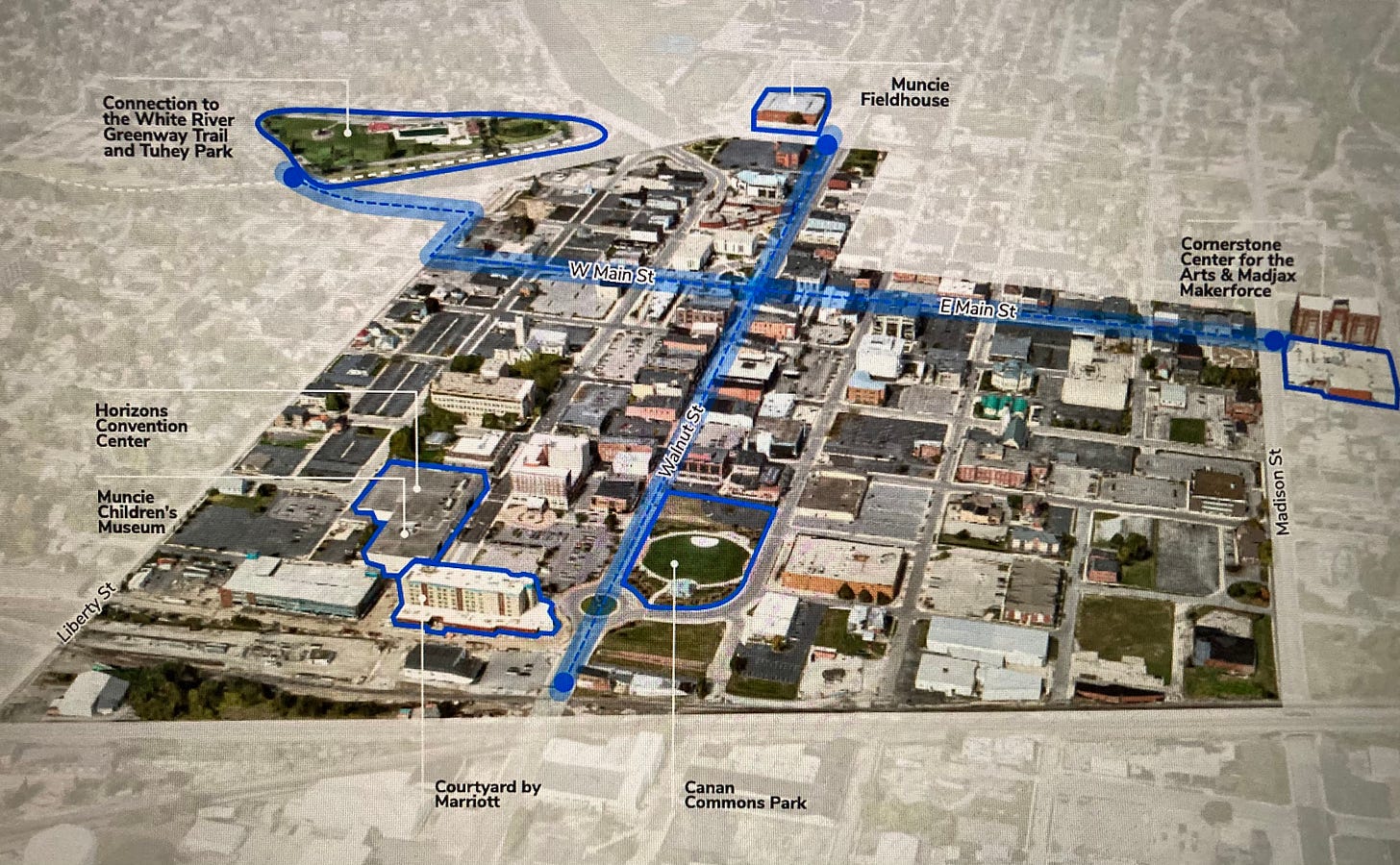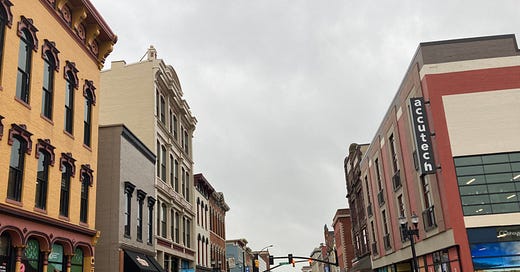Finally: A plan that admits we're shrinking
Submit your comments on the future of greater Muncie by Nov. 26
MUNCIE — You have until the day after Thanksgiving to add your comments to a draft comprehensive plan for greater Muncie — a game plan that finally acknowledges the reality of decades of depopulation and the potential for further decline.
As a Rust Belt community, the Muncie area first needs to “get the basics right” before it can put itself on track to eventually “go beyond the basics,” according to the authors of the plan, known as “TogetherDM,” alluding to Delaware-Muncie.
The 124-page draft plan calls for much-needed road and street improvements; finishing the revitalization of downtown; higher standards for new development along major corridors and gateways; a greater commitment of local public resources, possibly through a hike in the local income tax, which is lower than average; cultivation of neighborhood leadership; viable Main Streets in surrounding towns; locally grown/raised food; and many other strategies.
“TogetherDM’s direction is about making incremental and visible progress,” the authors wrote. “Every pothole that gets filled, every house that gets a new coat of paint, and every child empowered by literacy is a step forward that builds the community’s confidence to do more and expect more.”
Despite the creation of the Delaware-Muncie Metropolitan Plan Commission in 1965, and despite the fact that the 2020 Census marked the fifth straight time that Delaware County’s population declined from the previous census, rarely has the community “planned in the context of historic population loss, or formally taken into consideration the potential for further decline,” the draft plan says.
That was certainly the case when the last city-county comprehensive plan was adopted, in 2000.
“Population projections used by that plan — provided by a national economic analyst — anticipated 134,000 residents in the county by 2020, up from the 120,000 counted in the 1990 Census. The actual 2020 Census total was 111,900 – or 22,000 fewer residents than predicted in the late 1990s,” the draft plan notes.
The 2000 plan predicted population growth even while it acknowledged the community’s then-recent loss of Ball Corp. headquarters and the then-recent downsizings and closings by manufacturing and other major employers.
But instead of planning for loss over the past half century, Muncie and other Rust Belt cities “were planning for growth that never happened.”
For greater Muncie, “the failure of growth to materialize — combined with a slowness to adjust to this reality and adapt accordingly — has accelerated the decline of basic infrastructure and diminished the region’s ability to retain what it has,” the draft plan says.
“Costs that were shifted to an imagined — and larger — Delaware County in decades past have been coming due. And the community has often responded to these proverbial bills by making the minimum payment, as if it still expected someone else to cover the rest.
“While a timeline of the 20 years since the adoption of the last comprehensive plan might highlight key economic events — businesses closing, businesses opening, global or technological forces influencing everything from agriculture to retail to education and healthcare — the most noticeable story of the past two decades may be the steady accumulation of deferred investments in roads, homes, parks, and even in the capacity of governments and institutions to proactively respond to community needs.”
The draft plan estimates that Delaware County will have 109,620 residents in 2040 — a slightly smaller population than the 111,903 count from the 2020 Census.
But the authors acknowledge that population projections are educated guesses.
“If birth rates fall faster than expected, or if the gravitation of households and jobs to major metropolitan areas accelerates, the population might decline faster than projected,” they wrote. “If a post-COVID economy favors remote working in less congested areas, or if climate change leads to population shifts away from coastal areas, smaller losses (or even growth) might be possible.”
Regardless, if it gets the basics right, 20 years from now Delaware County will have become a community where quality of place has improved, opportunities for upward mobility have expanded, and housing conditions and options have strengthened, the draft plan suggests.

Here are excerpts of a few of the many choices that the draft plan says will create a stronger community. It was authored by Peter Lombardi, an urban planner at cbz, Alexandria, Va., and Matt Ingalls, a landscape architect from Fairport, N.Y.
Downtown, the heart of the community, is not finished
“Walnut Street’s current success is a demonstration of getting the basics right in downtown Muncie. It represents highly focused investment on a few blocks to create something truly memorable. Remaining focused, instead of scattering investments, will be key, and creating a strong Walnut Street/Main Street axis to connect community assets will help to build critical mass.”
Walnut and Main are the locations for new infill development, linking to community assets Tuhey Park/White River on the west; the Muncie Fieldhouse on the north; Canan Commons and Courtyard by Marriott on the south, and Madjax Makerforce and Cornerstone Center for the Arts on the east.
“Within a quarter mile of downtown, there are approximately 1,100 (1.5% of Muncie’s total population) at the present time. While the population for similar sized cities in America varies considerably, a city of Muncie’s size should have about 5% (3,400 people) of the city’s population downtown to achieve a self-sustaining sense of viability.
“Downtown is a neighborhood and competes with every other neighborhood for residents, new development, and recognition. This competition need not come at the expense of others if proximity to a strong downtown becomes an important selling point for neighborhoods across the city. This is especially true for neighborhoods next to downtown, specifically the Old West End, Gilbert, McKinley and East Central neighborhoods. These four neighborhoods, which declined during the late 20th century, should benefit from their proximity to downtown’s many employment, service, and entertainment offerings. Just as importantly, downtown should benefit from a surrounding residential base that feels connected to downtown and spends money there.”
Healthy neighborhoods
“Notable strides have been made since 2010 to lay a groundwork for healthier neighborhoods in Muncie,” including “more neighborhood associations with more volunteers,” and hundreds of blighted properties dealt with.
“But progress has often felt frustratingly slow or fleeting. And the number and scale of issues to address — such as the 6,100 properties that showed signs of deferred maintenance in the TogetherDM condition survey — remain daunting.
“In light of the strides made and the challenges that persist, this plan’s goal for Muncie’s neighborhoods is the achievement of healthier neighborhoods one block at a time. Whole block strategies, supported by the right partners and resources, have the potential to stimulate revitalization in a way that is tangible, builds confidence, spreads a sense of collective ownership, and inspires action on successive blocks.”
Strategies include boosting the images of neighborhoods, cultivating neighborhood leadership, improvement of physical conditions, code enforcement and compliance assistance, demolition and reinvestment.
Infrastructure
Better road and street conditions are needed everywhere in Delaware County and the city of Muncie. Current conditions reflect very limited levels of local investment in basic infrastructure over the past few decades.
Planning, quality of place
“Zoning ordinances in Delaware County are outdated. At their core, they reflect practices from the mid-20th century that often fail to deliver what communities are seeking today in terms of quality of place. Updates and patches have improved regulations in recent years, but a complete revamp is needed to ensure that development regulations and design standards fully reflect TogetherDM’s vision.
“More resources are also needed for planning in general, which is exceptionally under-resourced for a community of Delaware-Muncie’s size. Implementation of TogetherDM will require a high level of coordination across a range of departments and municipal boundaries, as well as advanced technical and management skills.”
Public spaces, quality of place
“Muncie is a city with outstanding public spaces. Scenic parks laid out in the early 20th century, trails along the White River, one of Indiana’s most picturesque university campuses, the bustle of Walnut Street downtown — all of these and more represent a legacy of building a high quality public realm that should be maintained and continued.
“This plan’s goal for Muncie’s Parks and Connective Corridors is a recommitment to Muncie’s legacy of high-quality public spaces, and the connection of those spaces by streets that exemplify community pride.”

Rural and agriculture
“When it happens, greenfield development is focused and not scattered. Incentivize local farming and ensure the farm-to-table economy satisfies the needs of local restaurants, grocers and residents. A growing share of farmland is formally conserved. Green energy production is a viable and regulated way to supplement farm income or promote farmland recuperation.”
Town centers
“This plan’s goal for the County and Town Neighborhoods of Delaware County is to boost levels of collective action in order to address current or pending challenges with regard to blight, infrastructure repair, and community competitiveness.
“A coordinated county-wide approach to developing viable Main Street districts will help to direct commercial growth and development to established centers instead of rural corridors. A coordinated initiative will also help each district by distributing human and financial resources appropriately and ensuring that districts complement rather than compete with each other.”
Develop a Countywide Main Street / Town Center program — a model to consider is the National Main Street Center’s Four-Point Approach.
Previously, in Greater Muncie:
Muncie’s future hinges on ‘getting back to the basics’






Also, the draft comprehensive plan calls for infill development on Walnut and Main streets in the heart of the downtown not at the school. There is also a regional plan calling for new housing in the old residential neighborhood directly east of the school
It has been reported that the YMCA plans to build a new facility on the grounds of Central HS